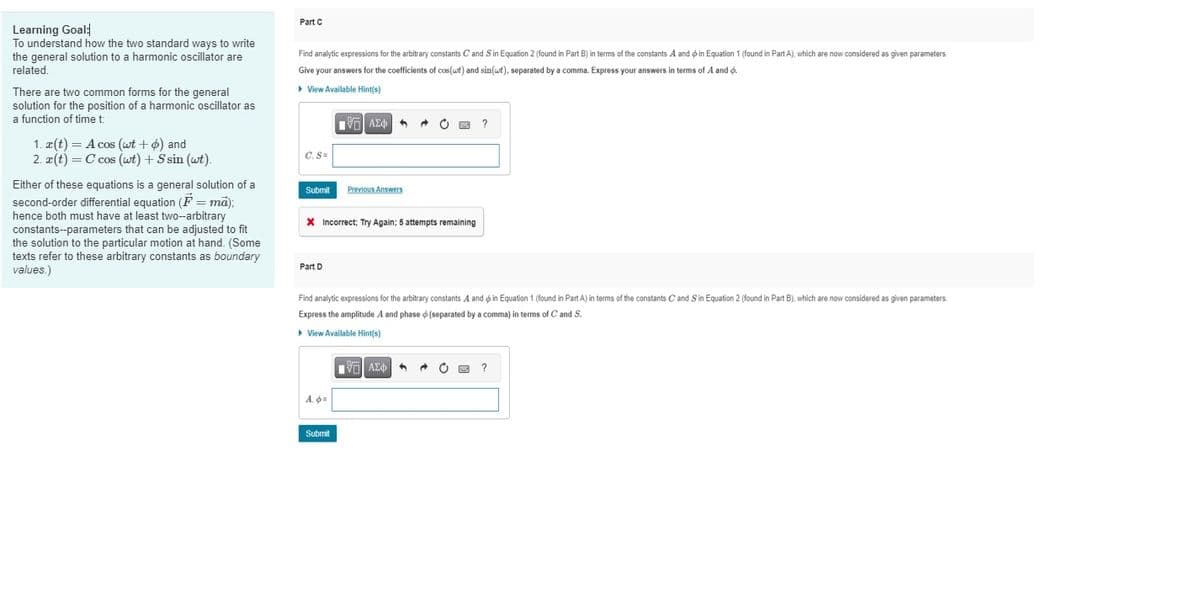Learning Goal To understand how the two standard ways to write the general solution to a harmonic oscillator are related. There are two common forms for the general solution for the position of a harmonic oscillator as a function of time t 1. z(t)= A cos (wt+) and 2. z(t)=C cos (wt) + Ssin (wt). Either of these equations is a general solution of a second-order differential equation (F=ma); hence both must have at least two-arbitrary constants--parameters that can be adjusted to fit the solution to the particular motion at hand. (Some texts refer to these arbitrary constants as boundary values.) Part C Find analytic expressions for the arbitrary constants C and Sin Equation 2 (found in Part B) in terms of the constants A and in Equation 1 (found in Part A), which are now considered as given parameters Give your answers for the coefficients of cos(ut) and sin(at), separated by a comma. Express your answers in terms of A and View Available Hint(s) VAL C.S= Submit Previous Answers 0? X Incorrect, Try Again; 5 attempts remaining Part D Find analytic expressions for the arbitrary constants A and in Equation 1 (found in Part A) in terms of the constants C and Sin Equation 2 (found in Part B), which are now considered as given parameters Express the amplitude A and phase (separated by a comma) in terms of C and S View Available Hint(s)
Learning Goal To understand how the two standard ways to write the general solution to a harmonic oscillator are related. There are two common forms for the general solution for the position of a harmonic oscillator as a function of time t 1. z(t)= A cos (wt+) and 2. z(t)=C cos (wt) + Ssin (wt). Either of these equations is a general solution of a second-order differential equation (F=ma); hence both must have at least two-arbitrary constants--parameters that can be adjusted to fit the solution to the particular motion at hand. (Some texts refer to these arbitrary constants as boundary values.) Part C Find analytic expressions for the arbitrary constants C and Sin Equation 2 (found in Part B) in terms of the constants A and in Equation 1 (found in Part A), which are now considered as given parameters Give your answers for the coefficients of cos(ut) and sin(at), separated by a comma. Express your answers in terms of A and View Available Hint(s) VAL C.S= Submit Previous Answers 0? X Incorrect, Try Again; 5 attempts remaining Part D Find analytic expressions for the arbitrary constants A and in Equation 1 (found in Part A) in terms of the constants C and Sin Equation 2 (found in Part B), which are now considered as given parameters Express the amplitude A and phase (separated by a comma) in terms of C and S View Available Hint(s)
Related questions
Question
Needs Complete typed solution with 100 % accuracy.

Transcribed Image Text:Learning Goal:
To understand how the two standard ways to write
the general solution to a harmonic oscillator are
related.
There are two common forms for the general
solution for the position of a harmonic oscillator as
a function of time t:
1. x(t) = A cos (wt + p) and
2. x(t) = C cos (wt) + Ssin (wt).
Either of these equations is a general solution of a
second-order differential equation (F = mā);
hence both must have at least two--arbitrary
constants--parameters that can be adjusted to fit
the solution to the particular motion at hand. (Some
texts refer to these arbitrary constants as boundary
values.)
Part C
Find analytic expressions for the arbitrary constants C and S in Equation 2 (found in Part B) in terms of the constants A and in Equation 1 (found in Part A), which are now considered as given parameters.
Give your answers for the coefficients of cos(wt) and sin(wt), separated by a comma. Express your answers in terms of A and
▸ View Available Hint(s)
C.S=
Submit
Part D
195) ΑΣΦ
A. =
Submit
4
Previous Answers
X Incorrect; Try Again; 5 attempts remaining
[ΕΙ ΑΣΦ
A
Find analytic expressions for the arbitrary constants A and in Equation 1 (found in Part A) in terms of the constants C and S'in Equation 2 (found in Part B), which are now considered as given parameters.
Express the amplitude A and phase (separated by a comma) in terms of C and S.
▸ View Available Hint(s)
^
C
A
?
C
?
Expert Solution
This question has been solved!
Explore an expertly crafted, step-by-step solution for a thorough understanding of key concepts.
This is a popular solution!
Trending now
This is a popular solution!
Step by step
Solved in 4 steps with 9 images
